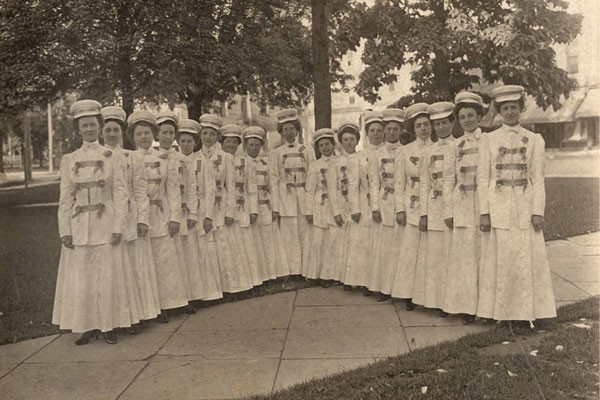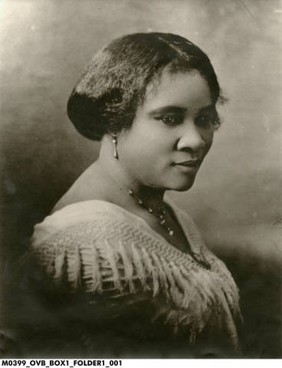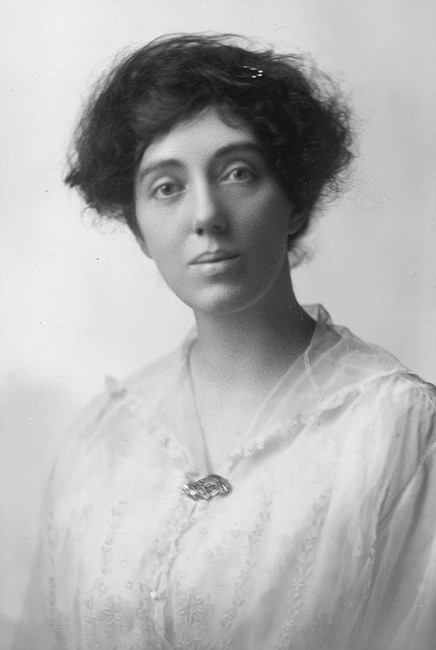Indiana Women's Suffrage Historical Marker (Ratification on January 16, 1920)
Introduction
Text-to-speech Audio
This historical marker was dedicated in 2022 and recognizes Indiana’s women’s suffrage movement, which began shortly after the Seneca Falls convention in 1848. Although several measures to recognize women's right to vote were passed in 1917, the state Supreme Court intervened, and the women of the Hoosier State could not legally vote until Indiana ratified the 19th Amendment on January 16, 1920.
Images
Indiana Suffragists

Suffragists in Auburn, Indiana in the early 1910s (Indiana Historical Society)

African American women had their own suffrage organizations due to segregation. One of these organizations met in the home of entrepreneur Madam C. J. Walker

Eleanor P. Barker was chair of the Indiana chapter of the National Woman's Party in the 1910s

Backstory and Context
Text-to-speech Audio
Indiana resident Amanda Way organized a women’s rights convention in 1851, and soon after, suffragists organized the Indiana Woman’s Rights Association. Women sent their first petition about voting to the state legislature in 1859, but the Civil War interrupted much of the movement. After the Civil War ended, suffragists got back to work. They were hampered by the structure of the state constitution amendment process. To change the constitution, an amendment needed to be approved by two separate legislative sessions (which only met every other year). This proved to be a problem in the 1880s when the state legislature approved a suffrage amendment in 1881. However, when the legislature reconvened in 1883, the law had mysteriously not been recorded in the official record, and they could not act on it.
Indiana suffragists continued campaigning into the twentieth century and again almost won the vote in 1917. Partially due to the national suffrage movement and the participation of women in war efforts, the Indiana General Assembly passed several pro-women's suffrage measures. One such measure called for a convention to draft a new state constitution, one was an amendment to grant women’s suffrage in the current constitution, and the third granted partial suffrage to women, allowing them to vote in certain elections that year. 40,000 Indiana women registered to vote, but the victory was temporary.
Opponents of women’s suffrage challenged two of the laws passed by the General Assembly, and the Indiana Supreme Court found both to be unconstitutional. Women lost their partial suffrage in October 1917, and there would be no convention to change the state constitution. The law granting full suffrage still needed to go through a second legislative session in 1919 to pass. With this second major setback, many women focused on the national campaign that led to the passage of the 19th Amendment. Indiana ratified the 19th Amendment on January 16, 1920.
Sources
"Indiana and the 19th Amendment." National Park Service. January 12, 2020. Accessed July 12, 2021. https://www.nps.gov/articles/indiana-and-the-19th-amendment.htm.
Morgan, Anita. "'An Act of Tardy Justice': The Story of Women's Suffrage in Indiana. 2019. Accessed July 12, 2021. https://indianasuffrage100.org/indiana-womens-suffrage-history/.
"Securing the Vote: Women's Suffrage Exhibit Hits the Road." We Do History. Accessed July 12, 2021. https://indianahistory.org/stories/securing-the-vote-womens-suffrage-exhibit-hits-the-road/.
Morgan, Anita. "'An Act of Tardy Justice': The Story of Women's Suffrage in Indiana. 2019. Accessed July 12, 2021. https://indianasuffrage100.org/indiana-womens-suffrage-history/.
"Indiana and the 19th Amendment." National Park Service. January 12, 2020. Accessed July 12, 2021. https://www.nps.gov/articles/indiana-and-the-19th-amendment.htm.
"Indiana and the 19th Amendment." National Park Service. January 12, 2020. Accessed July 12, 2021. https://www.nps.gov/articles/indiana-and-the-19th-amendment.htm.
